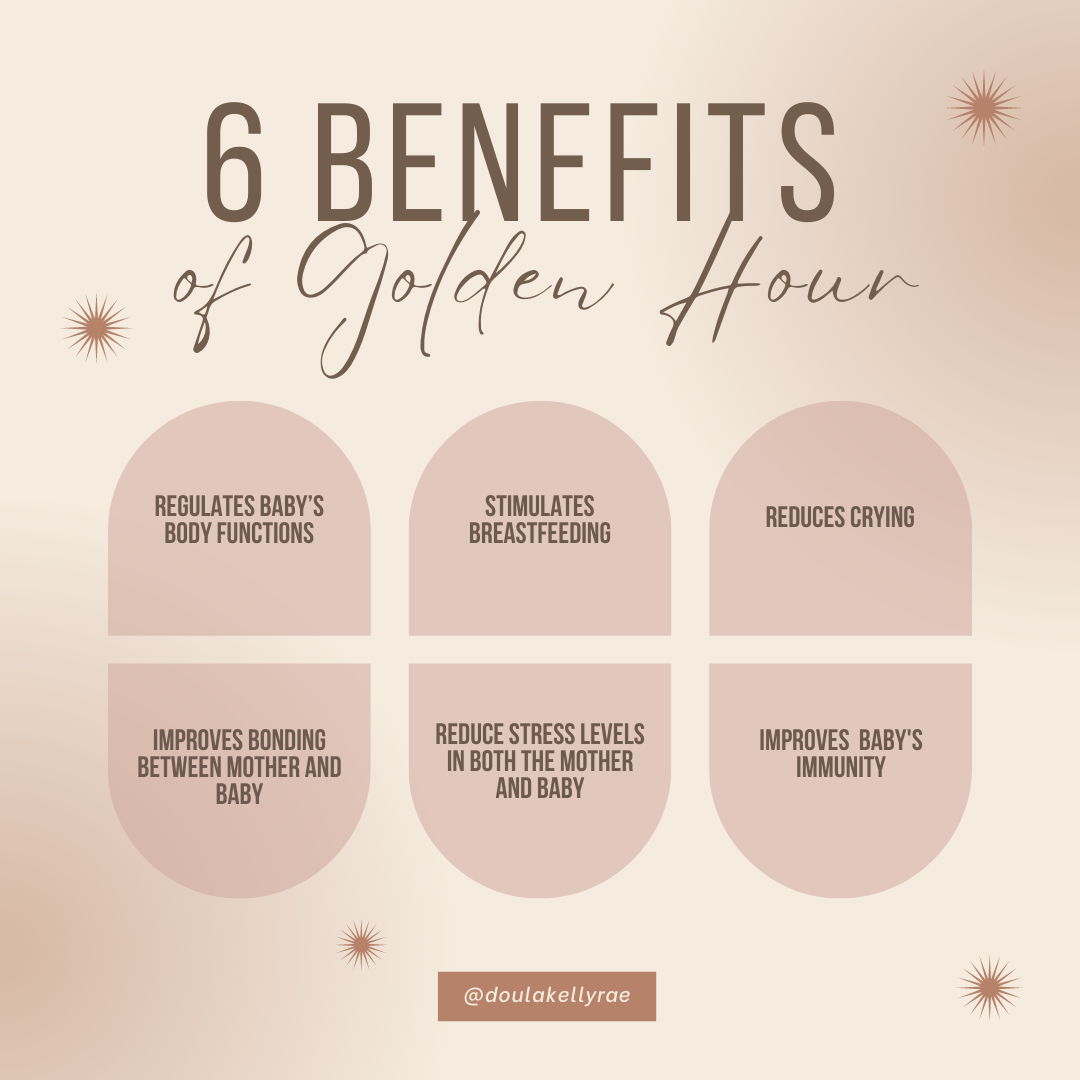
Golden Hour After Birth
Imagining that first moment when your baby is placed on your chest can bring so much excitement and comfort - and there is good reason - our human instinct craves this experience because making skin-to-skin contact with your baby immediately after birth has physiological benefits for both your baby and for you!
There is even a special term for this moment, it’s called ✨ The Golden Hour ✨
The first hour after birth is critical for a newborn baby as the past nine months were spent in a controlled environment.
The Benefits of Golden Hour
What is Golden Hour? The Golden Hour is a term used to describe a period of time immediately following birth during which certain actions can benefit both the new parent and her newborn.
During this time, the newborn is monitored, assessments are performed while the baby is in skin-to-skin contact, and interventions are delayed. The goal is to help your newborn transition into life outside the womb and adapt to their new environment, which is accomplished through immediate skin-to-skin contact.Golden Hour is an evidence-based practice that has become the standard of care in most hospitals around the world.
So what are the benefits?
During this time, your baby will be placed on your chest or belly so you can bond through skin-to-skin contact. This helps regulate your baby's body temperature, heart rate and breathing patterns. It also helps you bond with your new baby.
Skin-to-skin contact is important for newborns and the new parent. It has many benefits, including:
Regulates baby’s body functions: Research shows that skin-to-skin care after birth can stabilize cardiorespiratory systems, blood glucose levels, stress levels, body temperature, and nervous system regulation. Delivery becomes less of a shock to the baby’s system.
Stimulates breastfeeding: Skin-to-skin contact stimulates the release of oxytocin in both the new parent and baby — the hormone responsible for initiating breastfeeding. Those who have skin-to-skin contact with their babies immediately after delivery are more likely to breastfeed successfully than those who don’t.
Reduces crying: Babies who are held skin-to-skin cry less than babies who aren’t held. They also have stronger immune systems thanks to the hormone released during skin-to-skin contact.
Improves bonding: Holding your baby while they are still attached by the umbilical cord helps you bond with them right away — which means they will cry less often because they know they have someone to comfort them
It also helps reduce stress levels, which can have an impact on the baby's overall health and wellbeing. Your body and your baby's body have been through a lot. Both of you are exhausted, possibly in pain and definitely in need of rest. Research has documented measurably lower stress levels after just 1 hour of skin-to-skin care.
Incorporating Golden Hour Into Your Birth Plan
Your birth plan document doesn’t end with pushing, it should also include your preferences for immediate postpartum care (i.e. placenta delivery) and newborn interventions.
Here are some suggestions for how to include requests on your birth plan to protect the golden hour:
✨ Immediate skin-to-skin after birth
✨ Delayed cord clamping (or better yet, specifically state: Wait to clamp cord until it has turned white and stopped pulsating)
✨ Perform any immediate newborn assessments/interventions while skin-to-skin (i.e. APGAR scores, stimulating baby, checking temperature/oxygen levels, etc.)
✨ Delay any non-urgent newborn interventions such as weighing baby, administering Vitamin K or other newborn medications, wiping off vernix (in fact, research suggests leaving it on and letting it rub off naturally can improve your baby's immunity and gut health!) until after the golden hour
If you have a doula supporting your birth, they can also help advocate for your preferences for newborn care and help you protect the golden hour when medically safe to do so! Did you know your doula stays with you until 1-2 hours after birth also?!
If you have questions on how a doula can support you through your journey, contact us to chat further about what a doula supported birth can look like for you!
If you’re local to the San Diego area, join us for one of our monthly meet ups where you can connect with other pregnant people IRL and maybe even meet your new “birth bestie”!
Check out the event calendar here.

*References
Einion A. Hormonal physiology of childbearing: evidence and implications for women, babies and maternity care. Pract Midwife. 2017 Apr;20(4):31-34. PMID: 30549960.
“By Elizabeth Smith and Terriann shell delayed bathing.” [Online]. Available: https://icea.org/wp-content/uploads/2018/02/ICEA-Position-Paper-Delayed-Bathing.pdf. [Accessed: 13-Mar-2023]
Join our mailing list
Receive pregnancy, birth, and postpartum tips straight to your inbox. Stay informed on upcoming events, classes, meetups in San Diego County.
We are very intentional about emails and do not spam. We will never sell your information.

